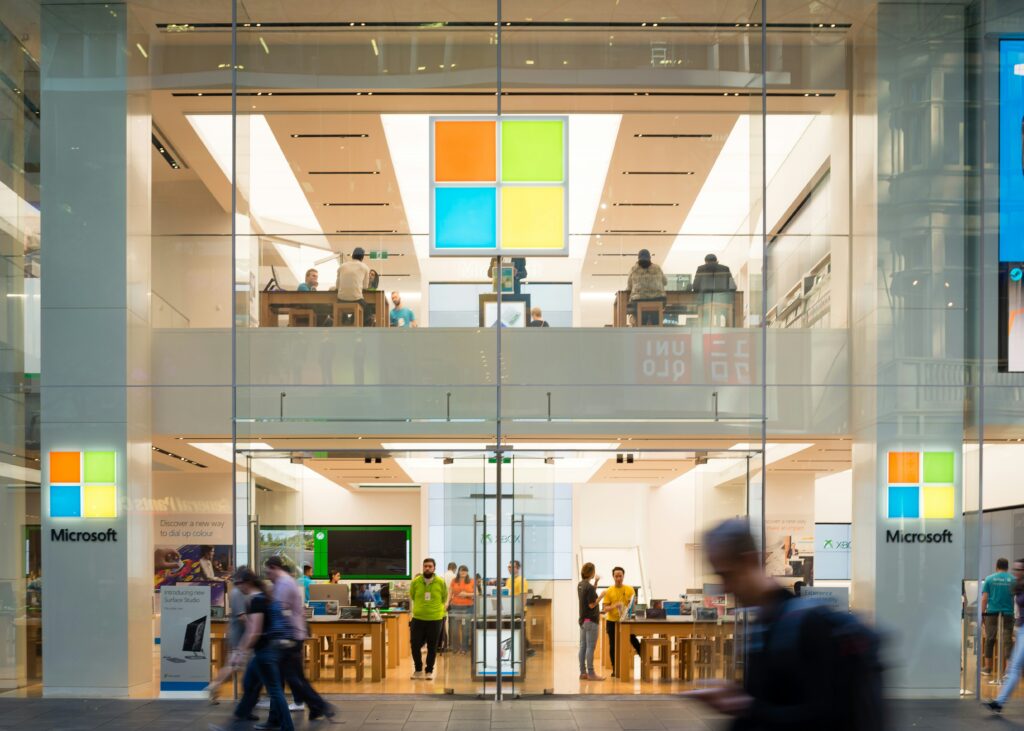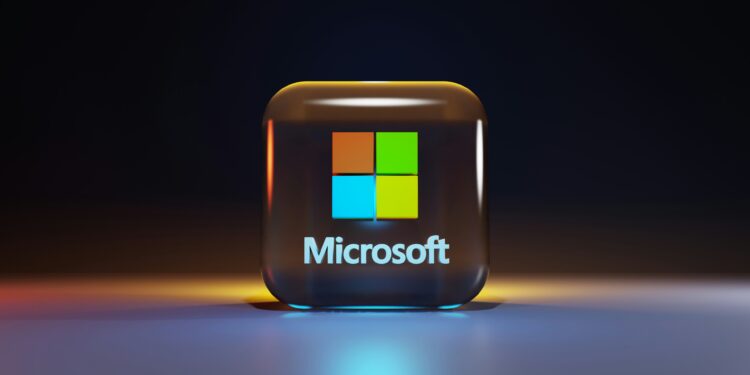Microsoft Corporation (NASDAQ:MSFT), founded in 1975 by Bill Gates and Paul Allen with a simple mission to create software for the emerging personal-computer market, has grown into a trillion-dollar powerhouse whose technologies now underpin nearly every facet of modern digital life. From its humble beginnings in Albuquerque—where the pair wrote Altair BASIC and registered the hyphenated name “Micro-Soft”—the company relocated to Washington State, launched MS-DOS, and then revolutionized personal computing with successive generations of the Windows operating system and the Microsoft Office productivity suite. Over the decades Microsoft fortified its dominance through a mix of relentless internal innovation and high-impact acquisitions, building an unrivaled ecosystem that stretches from consumer devices and enterprise software to developer tools and gaming.
A pivotal inflection point arrived in February 2014 when Satya Nadella became only the third CEO in company history; he swiftly pivoted Microsoft away from a Windows-centric worldview toward a cloud-first, AI-first strategy, igniting hypergrowth in the Azure cloud platform and ushering in a new era of openness, cross-platform support, and subscription-based business models. Strategic deals such as the $26 billion purchase of LinkedIn in 2016, the $7.5 billion acquisition of GitHub in 2018, and the landmark $68.7 billion takeover of Activision Blizzard completed in 2023 have deepened Microsoft’s reach into professional networking, open-source development, and interactive entertainment.
Today the company is investing tens of billions of dollars in artificial-intelligence infrastructure and embedding its Copilot generative AI across productivity, cloud, and developer workflows; internally, managers now evaluate employees on how effectively they leverage AI tools, underscoring leadership’s all-in commitment to an AI-powered future. Even as Microsoft streamlines layers of management and reallocates resources—most recently trimming about four percent of its workforce to fund an estimated $80 billion capex program for new data centers—the firm’s balance-sheet strength, diversified revenue streams, and unparalleled software distribution channels position it as a foundational enabler of the next wave of digital transformation.
With Azure continuing to gain share, Microsoft 365 monetizing AI features, the Xbox ecosystem integrating blockbuster Activision IP, and an end-to-end security stack safeguarding enterprises worldwide, Microsoft stands poised to compound earnings and free cash flow for years to come, reinforcing its status as one of the most resilient and forward-thinking companies in the global technology landscape.
Azure and AI Remain the Company’s Primary Growth Engines
Azure, Microsoft’s cloud platform, continues to be the company’s most powerful growth engine. In fiscal Q3 2025, Azure and other cloud services delivered 22% year-over-year revenue growth, capturing more enterprise market share while cementing its status as the leading alternative to Amazon Web Services. With AI now embedded into virtually every layer of its cloud infrastructure, Microsoft is positioning Azure as the go-to destination for businesses building generative AI, large language models, and intelligent applications. Azure’s integration with GitHub, Power Platform, and Microsoft 365 gives Microsoft an unrivaled ecosystem effect—one that combines developer tools, cloud scalability, data analytics, and enterprise-grade security in a single unified environment.
The company’s deep partnership with OpenAI continues to pay dividends. Microsoft has exclusive rights to integrate OpenAI’s GPT-4 and future models into its core products, a strategy that is already transforming its productivity suite. Copilot, Microsoft’s AI assistant, has been fully rolled out across Word, Excel, Outlook, PowerPoint, and Teams, unlocking massive efficiency gains and creating new pricing tiers for enterprise customers. The result is a flywheel of higher user engagement, AI-driven upsells, and long-term customer retention.

CHECK THIS OUT: POET Technologies (POET) Delivers 1.6T Optical Innovation—Is a Massive Revenue Surge Next? and BigBear.ai (BBAI) is Flying Under the Radar—But Not for Long. Here’s Why Bulls Are Piling In.
Internal AI Push Reflects Microsoft’s All-In Strategy
Internally, Microsoft is also reinforcing its AI-first transformation. On June 27, 2025, Julia Liuson, Microsoft’s head of AI tools and services, instructed company leaders to begin evaluating employees based on their usage of internal AI tools. This policy reflects Microsoft’s belief that AI adoption must start from within and signals how seriously the company is taking its Copilot initiative. The move comes amid lagging internal adoption of AI tools, and management is determined to accelerate cultural alignment with its external AI ambitions.
Microsoft has even allowed employees to experiment with external AI platforms like Cursor, provided they meet specific security protocols. This pragmatic yet aggressive strategy highlights Microsoft’s commitment to driving AI innovation without compromising enterprise security—an approach that aligns well with CIOs navigating digital transformation amid rising cyber risks.
Strategic Layoffs and AI Investment Rebalance the Workforce for Long-Term Gains
In July 2025, Microsoft confirmed plans to lay off approximately 4% of its global workforce—impacting an estimated 9,000 jobs. This decision, while difficult, is a strategic move as the company reallocates resources to support its massive $80 billion capital expenditure budget for AI infrastructure. Earlier in May, Microsoft had already cut 6,000 jobs, mostly in sales. These streamlining efforts reflect a broader corporate initiative to simplify layers of management, consolidate redundant roles, and focus investments on high-impact areas like AI data centers, cloud engineering, and security.
Though margins may temporarily be compressed due to high capital spending, Microsoft’s rebalancing demonstrates long-term thinking. The company is sacrificing short-term optics for long-term dominance in artificial intelligence infrastructure. It is important to note that despite these cuts, Microsoft still retains over 228,000 employees globally—highlighting the scale at which it continues to operate and innovate.
Productivity Software and Microsoft 365 Copilot Monetization Gains
The core Office productivity suite, rebranded as Microsoft 365, continues to be a durable revenue stream, further enhanced by the company’s AI integrations. Microsoft 365 Copilot, now fully embedded into enterprise subscriptions, has not only boosted functionality but has also driven higher revenue per user. In the second half of fiscal 2025, over 60% of Microsoft 365 enterprise customers were actively using Copilot features—supporting strong retention rates and creating a new layer of recurring SaaS revenue.
Beyond enterprise, Microsoft is also targeting education, government, and SMB markets with tiered AI-enhanced subscriptions. With over 300 million monthly active Office users globally, the revenue potential from Copilot is staggering. The success of this AI monetization strategy could rival—or even surpass—the monetization trajectory seen during the company’s cloud transformation under Nadella’s leadership.
Gaming Continues to Expand Through Activision Integration and Game Pass
In the gaming space, Microsoft has strengthened its position through the full integration of Activision Blizzard, completed in 2024. Flagship IPs like Call of Duty and Diablo have been added to Xbox Game Pass, dramatically increasing subscriptions and playtime across console and PC. Microsoft’s vision is to make Xbox not just a console, but a cloud-first gaming platform accessible across devices—aligning with the company’s broader cloud strategy.
Even with some restructuring in the gaming division, the long-term strategy remains intact. The Xbox ecosystem now spans devices, subscriptions, streaming, and IP development—making it one of the most comprehensive gaming platforms in the world. This positions Microsoft to lead in the gaming-as-a-service era, further diversifying revenue and deepening consumer engagement.
Cybersecurity and Enterprise Trust Fuel Platform Stickiness
As cyberattacks grow more sophisticated and frequent, Microsoft’s security business is thriving. Security revenue exceeded $25 billion in 2024, with key products like Microsoft Defender, Sentinel, and Entra seeing rapid enterprise adoption. Microsoft’s end-to-end security stack integrates identity, endpoint, and cloud protection into a single platform—a major competitive advantage over niche vendors.
This security-first approach not only adds billions in high-margin revenue but also reinforces trust in Microsoft’s broader platform. In a world where digital trust is currency, Microsoft’s ability to offer a secure, AI-powered, cloud-based stack positions it as the vendor of choice for modern CIOs and CTOs.
Capital Expenditures and Long-Term Vision Support Future Dominance
Microsoft is deploying $80 billion in capex during fiscal 2025, the bulk of which is directed toward AI infrastructure, including custom silicon, data centers, and edge compute networks. This commitment dwarfs those of most competitors and signals the company’s intent to lead in the physical foundation of artificial intelligence. These investments will not only boost Azure’s capacity but will also support the next generation of applications—ranging from AI model training to real-time generative inference at scale.
Despite short-term margin pressure, this strategy lays the groundwork for Microsoft to become the default compute layer for AI innovation across industries.
Conclusion: Microsoft Remains the Defining Compounder of the AI Era
Microsoft Corporation continues to reinvent itself, from a legacy software provider to the global nerve center of digital productivity, cloud computing, and artificial intelligence. With its massive capital investments, strategic cost optimizations, rapid AI adoption, and a product ecosystem that touches nearly every enterprise function, Microsoft remains a best-in-class long-term compounder.
While near-term headwinds such as restructuring and margin compression may create noise, the long-term trajectory is clear: Microsoft is building the infrastructure, tools, and intelligence layer that will power global digital transformation for decades to come. For investors seeking stability, innovation, and exponential upside from AI, Microsoft remains not only relevant—it is essential.’
READ ALSO: MicroVision (MVIS): A Top Pick in Autonomous Tech Stocks and Innoviz (INVZ) May Be Severely Undervalued — Investors Shouldn’t Ignore This Stock.






